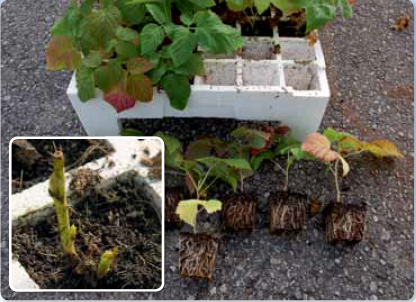Overwintered green plants are the quickest way to produce a full crop. These are micro-propagated, virus-free plants thinned out in the greenhouse, hardened off in the open air and overwintered in the chiller. There are 60 plants in each plant culture tray. The best time to plant is in April. In optimum conditions, the plants can put out several roots, even in their first year, and can reach a height of up to 2 metres. They achieve their full yield in the year after they are planted. Autumn-fruiting varieties produce a satisfactory yield as early as the year in which they are planted, if they are planted early enough.
Raspberries
Ripening periods, product specification, variety descriptions, planting advice
Ripening chart for raspberries

Tray-Plants
GEPE12 = overwintered green plants
GP 21 / 34 = fresh green plants
LC = Long Cane
GP12 = overwintered green plant
GP 21 / 34 = fresh green plant
LC = Long Cane
GEPE 12

GP 21 / GP 34

Virus-free green plants, produced in their year of planting, which are about 9-12 weeks old when they are delivered. The plants are cultivated in 60-plant culture trays, hardened off before delivery and have a height of about 10-15cm. In contrast to the overwintered green plants, these plants are herbaceous and not yet woody, so ground preparation needs to be carried out with particular care. Planting can be done from the end of May to the beginning of July and from the end of August to the end of September. If they are planted at the beginning of June, the green plants will achieve one or two shoots and a height of 100 to 180cm. In the following year, they will already achieve a yield of 50 to 80% of the full harvest (depending on the variety and the distance between the plants).
Long Canes

In raspberries, the harvest period can be restricted in a similar way to strawberries by the use of "Long Canes".Long Canes are cultivated in 1.8 - 2.5l pots in the preceding year. Two roots are usually cultivated per pot, at a height of 1.60 to 1.80 m. In winter, these plants are stored and cooled to -1.5 °C. In the following year, they can be taken out of the cold store at the required time and then planted. Fruit will start to be harvested from 70 to 90 days after planting, depending on the date of planting.
Available varieties:
- SANRAFAEL (s)
- TULAMEEN
- GLEN AMPLE (s)
- ENROSADIRA (s)
- OPTIMA (s)
Other varieties can be supplied if they are pre-ordered in good time.
Description of varieties
Planting advice raspberry
Growth site requirements
If the right variety and growth site are chosen, raspberry plants can be cultivated at 1,200 m above sea level. Valley floors and hollows should be avoided, as cold spots can form. Areas prone to late frost are also not ideal, as the young berries are susceptible to frost damage. Raspberries prefer soil that drains well, is rich in humus, deep and with neutral to slightly acidic pH. Compact, soggy soil should be avoided at all costs.
Planting
Place the raspberry plants deep enough into the ground so that the upper rim of the root ball is covered with 1-2 cm of earth. Make sure the root balls of the plants are thoroughly soaked before planting. Once planted, make sure the area around the roots remains sufficiently moist, particularly during the initial growth phase.
Recommendation
Raspberries have shallow roots and thrive in humus-rich, fertile soils. If you feed your raspberry plants with mature compost or well-rotted manure annually, before spring budding, you will maintain and enhance the fertility of the soil and thus the health and growth potential of your plants. Spread approx. 5 cm of compost or manure between the plants or along the planted rows. There is no need to work it in.
Practical information
- Schulstrasse 62
9323 Steinach(SWITZERLAND)
- Mon - Fri
- - -
- Sat - Sun
- Closed
Please note:
We propagate plants for commercial cultivation. Individual plants to private individuals cannot be offered.



